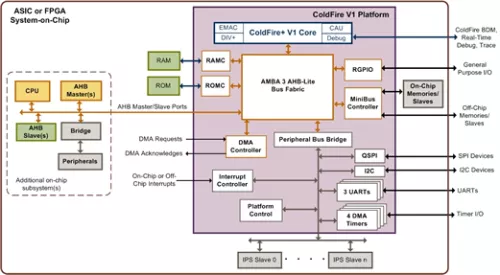The ColdFire V1 Platform is a fully configurable microcontroller subsystem built from the same ColdFire V1 32-bit processor IP that is implemented in ColdFire+ family devices from Freescale Semiconductor.
ColdFire+ family devices feature an enhanced version of the ColdFire V1 Core. The ColdFire V1 processor implemented in the ColdFire V1 Platform features:
An enhanced MAC (EMAC) unit
An improved hardware divider (DIV+)
Cryptographic Acceleration Unit (CAU)
Each of the above units is optional. The ColdFire V1 debug unit with single-wire debug interface and 64-entry trace buffer is also optional. By adjusting HDL parameter settings, you can explore various design tradeoffs and include only the hardware you need for your final implementation, resulting in the smallest and most power efficient core possible for your application requirements.
Similar to other ColdFire architecture processors, the ColdFire V1 processor used in the ColdFire V1 Platform features a variable-length instruction set for maximum code density, industry-standard AMBA 3 AHB-Lite system bus interface for rapid system integration, and a wide selection of development tools, operating systems, drivers, and libraries from both commercial and open source providers.
ColdFire V1 Processor Platform
Overview
Key Features
- On-board peripherals and their features include:
- RAM Controller (optional)
- Supports tightly-coupled RAM with single-cycle access
- RAM size can be 0, 2, 3, 4, 6, 8, 12, 16, 24, 32, 48, or 64 KB
- ROM Controller (optional)
- Supports tightly-coupled ROM with single-cycle access
- ROM size can be 0, 4, 8, 16, 32, 64, 128, 256, 512,
- or 1024 KB
- MiniBus Controller (optional)
- Connects one or two on-chip or off-chip memories/devices
- Independently programmable transfer characteristics for each device (wait states, address setup/hold, data width, multiplexed or non-multiplexed mode)
- DMA Controller (optional)
- Four independently programmable DMA channels
- Sixteen possible peripheral DMA requests per channel
- Support for channel linking
- Interrupt Controller
- Supports 30 peripheral interrupt requests plus seven software interrupt requests
- Unique vector for each interrupt source
- Supports low-power mode wake-up
- Queued SPI (QSPI) module (optional)
- Programmable queue for up to 16 SPI transfers
- Four chip-select lines for up to 16 devices
- Programmable baud rate, before-and-after transfer delays, clock phase and polarity
- I2C interface module (optional)
- Support for the original Philips I2C bus protocol
- Support for baud rates up to 3.4 Mbps
- 0–3 UARTS (optional)
- Programmable clock source, data formats, and modes (normal/loopback)
- Error detection
- Four maskable interrupt conditions
- 0–4 DMA Timer modules (optional)
- Programmable clock source
- Programmable prescaler
- Programmable interrupt or DMA request upon timer event
- Platform Control
- Software watchdog timer
- Reset status, low-power mode control, and core fault status registers
- The ColdFire V1 Platform features software-controlled shutdown of selected clocks to support a variety of chip-level low-modes:
- Independent shutdown of selected peripheral clocks
- Shutdown of the ColdFire V1 CPU clock in response to a ColdFire STOP instruction
- The ColdFire V1 Platform supports ColdFire Debug Architecture Revision B+, including:
- Single-wire Background Debug Mode (BDM) interface
- Real-Time Debug (RTD)
- On-chip, 64-entry trace buffer for low-cost trace over BDM
- Synthesizable Verilog source code
- Integration testbench and tests
- Documentation
- Scripts for simulation and synthesis with support for commonly-used EDA tools
- Synthesizable Verilog source code
- Integration testbench and tests
- Documentation
- Scripts for simulation and synthesis with support for commonly-used EDA tools
Block Diagram

Applications
Deliverables
Technical Specifications
Maturity
Silicon Proven
Availability
now